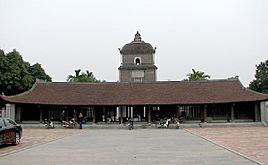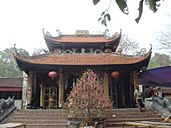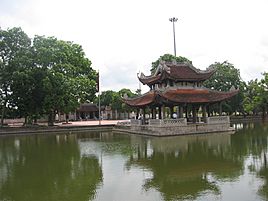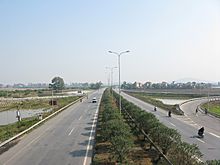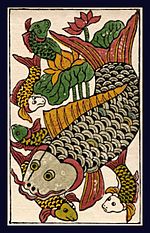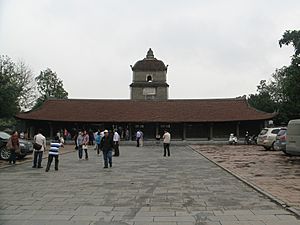Bắc Ninh province facts for kids
Quick facts for kids
Bắc Ninh province
Tỉnh Bắc Ninh
|
|
|---|---|
|
From top, left to right: Bắc Ninh City, Dâu Temple, Bảo Nghiêm Pagoda, Bà Chúa Kho Temple, and Lý Bát Đế Temple.
|
|
| Nickname(s):
The homeland of Quan họ
|
|
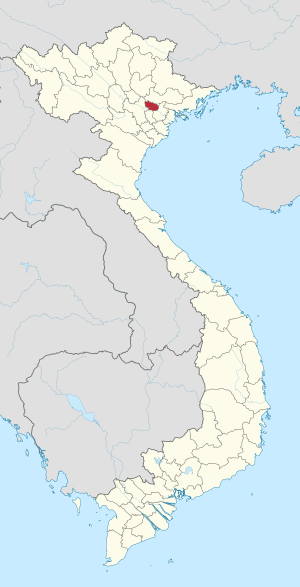
Location of Bắc Ninh within Vietnam
|
|
| Country | |
| Region | Red River Delta |
| Capital | Bắc Ninh |
| Subdivision | 2 cities, 2 district-level town and 4 rural districts |
| Government | |
| • Type | Province |
| • Body | Bắc Ninh Provincial People's Council |
| Area | |
| • Province | 822.71 km2 (317.65 sq mi) |
| Population
(2022)
|
|
| • Province | 1.488.250 |
| • Density | 0.001809/km2 (0.004684/sq mi) |
| • Urban | 763.770 |
| Ethnic groups | |
| • Vietnamese | 94.46% |
| • Tày | 1.79% |
| • Others | 3.75% |
| Time zone | UTC+7 (ICT) |
| Area codes | 222 |
| ISO 3166 code | VN-56 |
| Vehicle registration | 99 |
| HDI (2020) | 0.768 (7th) |
Bắc Ninh (Vietnamese: [ʔɓak̚˧˦ nïŋ˧˧]) is a province in Vietnam. It is located in the northern part of the country. Bắc Ninh is part of the Red River Delta region. It is the smallest province in Vietnam by land area.
The province is east of Hanoi, Vietnam's capital city. It shares borders with Bắc Giang province, Hưng Yên province, Hải Dương province, and Hanoi. Bắc Ninh covers an area of about 822.71 square kilometers. In 2022, its population was around 1,488,250 people. The name "Bắc Ninh" means "northern serenity."
Bắc Ninh is famous for its rich culture. It is especially known for Quan họ folk music. This special music style was recognized by UNESCO in 2009. It is an important part of the world's cultural heritage. Bắc Ninh has a high Human Development Index (HDI) score of 0.768. This ranks it seventh among all provinces and cities in Vietnam.
Contents
History of Bắc Ninh Province
Early History and Dynasties
During the ancient Hồng Bàng dynasty, Bắc Ninh was part of a region called bộ Vũ Ninh. Later, under the Lý dynasty and Trần dynasty, it was known as lộ Bắc Ninh. It then became thừa tuyên Kinh Bắc under the Lê dynasty. After that, it changed to trấn Kinh Bắc and Bắc Ninh. In 1831, during the Nguyễn dynasty, Emperor Minh Mạng officially named it Bắc Ninh province.
Modern Changes
On October 27, 1962, Bắc Ninh province joined with Bắc Giang province. They formed a new province called Hà Bắc province. This happened during the time of the Democratic Republic of Vietnam.
Later, on November 6, 1996, Hà Bắc province was split again. It became two separate provinces: Bắc Ninh and Bắc Giang. This change took place during the Socialist Republic of Vietnam era. Bắc Ninh province has been operating as a separate administrative area since January 1, 1997.
Geography of Bắc Ninh
Land Features
Bắc Ninh province has mostly flat land. The land gently slopes from north to south and from west to east. This slope helps rivers like the Đuống and Thái Bình flow through the province.
Most of the flat areas are 3-7 meters above sea level. There are some hills and mountains, but they are small. They are about 300-400 meters high. These hills make up only a tiny part (0.53%) of the province's total area. You can find them mainly in Quế Võ and Tiên Du districts. There are also some low, wet areas near river banks in certain districts.
Natural Resources
Bắc Ninh has a total land area of 822.7 square kilometers. About 54% of this land is used for farming. A very small part (0.7%) is forest land. Other areas are for buildings and special uses (31%). About 14.3% of the land is not used.
The province does not have many mineral resources. The main minerals found are materials for construction. These include clay in Quế Võ and Tiên Du. Sandstone is found in Thị Cầu, Vũ Ninh, and Bắc Ninh town. There is also some peat in Yên Phong.
Climate and Weather
Bắc Ninh has a warm humid subtropical climate. This means it has hot, humid summers and mild, relatively dry winters. The province is in a tropical monsoon region.
The average temperature each year is 24 °C. July is the hottest month, with temperatures around 30 °C. January is the coldest, with temperatures around 6 °C. Summers last from May to September. They are hot and humid, bringing most of the yearly rainfall (about 1680 mm). Winters are from November to March. They are mild and can be dry or humid. Spring in April often brings light rains. October is usually the nicest time of year for weather. The sun shines for about 1,530-1,776 hours each year. The air is usually quite humid, around 79%.
| Climate data for Bắc Ninh | |||||||||||||
|---|---|---|---|---|---|---|---|---|---|---|---|---|---|
| Month | Jan | Feb | Mar | Apr | May | Jun | Jul | Aug | Sep | Oct | Nov | Dec | Year |
| Record high °C (°F) | 31.6 (88.9) |
— | — | — | — | 41.3 (106.3) |
— | 39.4 (102.9) |
— | — | — | — | 41.3 (106.3) |
| Mean daily maximum °C (°F) | 19.9 (67.8) |
20.4 (68.7) |
23 (73) |
27.4 (81.3) |
31.8 (89.2) |
33 (91) |
32.8 (91.0) |
32.2 (90.0) |
31.2 (88.2) |
29 (84) |
25.6 (78.1) |
22.1 (71.8) |
27.4 (81.2) |
| Daily mean °C (°F) | 16.5 (61.7) |
17.4 (63.3) |
20 (68) |
24 (75) |
27.7 (81.9) |
29.2 (84.6) |
29.2 (84.6) |
28.8 (83.8) |
27.7 (81.9) |
25.2 (77.4) |
21.6 (70.9) |
18.5 (65.3) |
23.8 (74.9) |
| Mean daily minimum °C (°F) | 13.2 (55.8) |
14.4 (57.9) |
17.1 (62.8) |
20.6 (69.1) |
23.7 (74.7) |
24.6 (76.3) |
25.5 (77.9) |
25.4 (77.7) |
24.2 (75.6) |
21.4 (70.5) |
17.7 (63.9) |
14.9 (58.8) |
20.2 (68.4) |
| Average rainfall mm (inches) | 12 (0.5) |
33 (1.3) |
34 (1.3) |
87 (3.4) |
211 (8.3) |
245 (9.6) |
332 (13.1) |
337 (13.3) |
234 (9.2) |
98 (3.9) |
34 (1.3) |
23 (0.9) |
1,680 (66.1) |
| Source: climate-data.org | |||||||||||||
How Bắc Ninh is Governed
Bắc Ninh province is divided into 8 main areas. These include 2 cities, 2 towns, and 4 rural districts.
- Cities:
- Bắc Ninh (the capital city)
- Từ Sơn
- Towns:
- Quế Võ
- Thuận Thành
- Districts:
- Gia Bình
- Lương Tài
- Tiên Du
- Yên Phong
In 2022, Bắc Ninh province had a population of 1,488,250 people. These 8 main areas are further divided into 126 smaller units. These smaller units include 52 wards, 4 towns, and 70 communes.
The province is run by the Bắc Ninh province People's Committee. This is like an executive council with 9 members. The current chairman is Nguyễn Hương Giang. There are also vice-chairpersons who manage different parts of the province. The law-making part of the government is called the People's Council. It has 50 members. Both the committee and the council work under the province's Communist Party.
Local Government Areas
Here is a list of the main local government areas in Bắc Ninh province:
| Name | Type | Population (2009) | Area (km2) | Main Towns and Communes |
|---|---|---|---|---|
| Bắc Ninh | City | 270,426 | 82.6 | Wards: Đáp Cầu, Thị Cầu, Vũ Ninh, Suối Hoa, Ninh Xá, Tiền An, Vệ An, Vạn An, Kinh Bắc, Đại Phúc, Võ Cường, Vân Dương, Hạp Lĩnh, Hòa Long, Phong Khê, Khúc Xuyên, Kim Chân, Nam Sơn, Khắc Niệm. |
| Từ Sơn | City | 186,004 | 61.1 | Wards: Châu Khê, Đình Bảng, Đông Ngàn, Đồng Nguyên, Đồng Kỵ, Tân Hồng, Trang Hạ, Hương Mạc, Phù Chẩn, Phù Khê, Tam Sơn, Tương Giang. |
| Thuận Thành | Town | 179,140 | 117.8 | Hồ, An Bình, Đại Đồng Thành, Đình Tổ, Gia Đông, Hà Mãn, Hoài Thượng, Mão Điền, Nghĩa Đạo, Ngũ Thái, Nguyệt Đức, Ninh Xá, Song Hồ, Song Liễu, Thanh Khương, Trạm Lộ, Trí Quả, Xuân Lâm. |
| Quế Võ | Town | 212,081 | 155.1 | Phố Mới, Bằng An, Bồng Lai, Cách Bi, Chi Lăng, Đức Long, Châu Phong, Đào Viên, Đại Xuân, Hán Quảng, Mộ Đạo, Nhân Hoà, Ngọc Xá, Phượng Mao, Phương Liễu, Phù Lãng, Phù Lương, Quế Tân, Việt Hùng, Việt Thống, Yên Giả. |
| Tiên Du District | District | 190,677 | 95.6 | Lim, Cảnh Hưng, Đại Đồng, Hiên Vân, Lạc Vệ, Liên Bão, Minh Đạo, Nội Duệ, Phật Tích, Phú Lâm, Tân Chi, Tri Phương, Việt Đoàn, Hoàn Sơn. |
| Yên Phong District | District | 211,048 | 96.9 | Chờ, Dũng Liệt, Đông Phong, Đông Thọ, Đông Tiến, Hòa Tiến, Long Châu, Tam Đa, Tam Giang, Thụy Hòa, Trung Nghĩa, Văn Môn, Yên Phụ, Yên Trung. |
| Gia Bình District | District | 106,556 | 107.6 | Gia Bình, Giang Sơn, Song Giang, Đông Cứu, Lãng Ngâm, Đại Bái, Quỳnh Phú, Đại Lai, Xuân Lai, Nhân Thắng, Thái Bảo, Bình Dương, Vạn Ninh, Cao Đức. |
| Lương Tài District | District | 107,013 | 105.9 | Thứa, An Thịnh, Bình Định, Lai Hạ, Lâm Thao, Minh Tân, Mỹ Hương, Phú Hòa, Phú Lương, Quảng Phú, Tân Lãng, Trung Chính, Trung Kênh, Trừng Xá. |
Population of Bắc Ninh
| Historical population | ||||||||||||||||
| Year | Pop. | |||||||||||||||
| 1995 | 916,000 | |||||||||||||||
| 1996 | 925,300 | |||||||||||||||
| 1997 | 931,700 | |||||||||||||||
| 1998 | 937,600 | |||||||||||||||
| 1999 | 943,000 | |||||||||||||||
| 2000 | 950,600 | |||||||||||||||
| 2001 | 958,900 | |||||||||||||||
| 2002 | 967,600 | |||||||||||||||
| 2003 | 975,300 | |||||||||||||||
| 2004 | 983,200 | |||||||||||||||
| 2005 | 991,100 | |||||||||||||||
| 2006 | 999,800 | |||||||||||||||
| 2007 | 1,009,400 | |||||||||||||||
| 2008 | 1,018,100 | |||||||||||||||
| 2009 | 1,026,500 | |||||||||||||||
| 2010 | 1,041,200 | |||||||||||||||
| 2011 | 1.063,400 | |||||||||||||||
| 2012 | 1.085,800 | |||||||||||||||
| 2013 | 1.108,200 | |||||||||||||||
| 2014 | 1.131,200 | |||||||||||||||
| Sources: | ||||||||||||||||
Bắc Ninh is the smallest province in Vietnam by land area. However, it has a large number of people for its size. This means it has the highest population density of any province. On average, there are over 1,200 people living in every square kilometer of land.
In 2009, the population was 1,024,472 people. The population density was 1,262 people per square kilometer. This is 5 times higher than the national average for Vietnam. There are 27 different ethnic groups living in Bắc Ninh. Most of the people (99.67%) are ethnic Vietnamese.
Transportation in Bắc Ninh
Bắc Ninh is well-connected to other important places. It is about 30 kilometers from Hanoi, the capital. It is also close to Nội Bài International Airport. Major ports like Haiphong and Cái Lân Port are about 100 kilometers away. The Lạng Sơn border gate, which connects to China, is also nearby.
- Roads: The province has over 3,906.8 kilometers of roads. This includes 104.8 kilometers of national roads. These national roads connect Bắc Ninh to Hanoi, Lạng Sơn, Hạ Long, Hải Dương, and Haiphong. There are also provincial roads, district roads, and local village roads.
- Waterways: Three large rivers flow through Bắc Ninh. The Cầu River is 42 kilometers long. The Thái Bình River is 17 kilometers long. The Đuống River is also 42 kilometers long. There is a port called Đáp Cầu Port.
- Railways: A 20-kilometer railway line runs through Bắc Ninh. This line connects Hanoi and Lạng Sơn. There are four railway stations in the province. Another railway line is planned for the future.
- Electricity: Bắc Ninh has a stable power supply for homes and businesses. All districts and cities have access to the national electricity grid. All households in the province use electricity.
Economy and Industry
Bắc Ninh province is in an important location for trade. It is on a major route that links Vietnam and China. This area is growing fast, especially with the China - ASEAN free trade zone. Bắc Ninh is also part of important economic corridors. These include the Nanning - Lạng Sơn - Hanoi - Hai Phong corridor. It is also near the busy Hanoi - Hai Phong - Quảng Ninh economic area.
Bắc Ninh is known for its strong industrial growth. It has been developing quickly with modern industries.
Industrial Parks and Handicrafts
Bắc Ninh has 15 industrial parks. These parks cover a total area of 7,681 hectares. Nine of these parks are already working well. These industrial parks have attracted many foreign companies. Over 272 foreign projects have invested more than $3.7 billion here. Big companies like Canon, Samsung, Foxconn, and Nokia have invested in Bắc Ninh.
The province has also attracted 254 local projects. These projects have invested over $1 billion. They employ more than 83,000 workers.
Bắc Ninh is also home to about 120 traditional handicraft villages. Sixty-two of these villages make traditional products. For example, they make copper items in Đại Bái-Gia Bình. Iron and steel products come from Đa Hội-Từ Sơn. Wooden products are made in Đồng Kỵ-Kim Sơn. These traditional crafts are important for Bắc Ninh's economy.
Economic Growth
In 2015, the economy of Bắc Ninh grew by 8.7% compared to 2014. The economy has changed to focus more on industry. Farming, forestry, and fishing made up 5.3% of the economy. Industry and construction made up 75.6%. Services made up 19.1%.
The value of industrial production was estimated at 610 trillion VND. This was a 9.1% increase. Total sales of goods and services reached over 39.7 trillion VND, up 15.4%. The total value of goods exported was about US$23.2 billion, up 6.4%. The province's total government income was estimated at 14,500 billion VND, up 14.3%.
Culture and Traditions
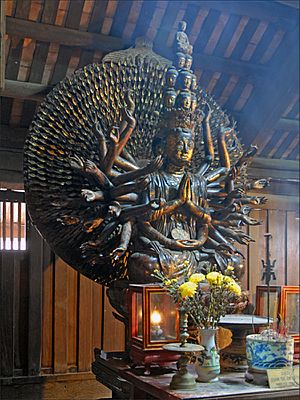
Bắc Ninh is a very important place in Vietnamese history and culture. It is the birthplace of Kinh Dương Vương, the first king of ancient Vietnam. It is also the home of eight kings from the Lý Dynasty.
The province has many old temples and cultural sites. These include Đô Temple, where the 8 Lý Dynasty kings are honored. Dâu Pagoda is the first pagoda in Vietnamese history. Bút Tháp Pagoda and Phật Tích Pagoda are also very old and important. Bắc Ninh hosts thousands of local festivals. These festivals have special meanings. Some famous ones are the Dâu Pagoda festival, Lim festival, Đô Temple festival, and Bà Chúa Kho temple festival.
Quan Họ Folk Music
The quan họ style of folk music started in what is now Bắc Ninh province. It was first recorded in the 13th century. This music is traditionally linked to spring festivals. These festivals happen after the Tết (Vietnamese New Year) celebration. Quan họ was recognized by UNESCO in 2009 as an Intangible Cultural Heritage.
Dong Ho Painting
The village of Đông Hồ in Bắc Ninh province is famous. It is known for making traditional Vietnamese woodblock prints. These prints are called Đông Hồ painting. They are sold all over Vietnam, especially for the Lunar New Year (Tết) celebrations.
Hồ Chicken
Hồ chicken (gà Hồ) is a special type of chicken from Bắc Ninh Province. It is a rare breed and a symbol in Vietnam. According to old stories, the male Hồ chicken has five qualities of an honorable man. These are literacy, martial arts skill, physical strength, kindness, and loyalty. A picture of a Hồ rooster welcoming the sun was used as a symbol for the 3rd Asian Indoor Games in 2009. This showed Vietnam's readiness to host the big sports event.
Festivals in Bắc Ninh Province
Here is a list of some important festivals in Bắc Ninh Province:
| Name of Festival and Time | Location | Meaning and Activities |
|---|---|---|
| Phật Tích Pagoda festival (4th of the first Lunar month) | Phật Tích commune, Tiên Du District | People worship "Quan Âm" Buddha and Emperor Lý Thánh Tông. Visitors pray for happiness and good fortune. |
| Đồng Kỵ fire-cracker festival (2nd of the first Lunar month) | Đồng Quang ward, Từ Sơn | People worship Thiên Cuồng Đế. Visitors pray for luck and happiness. There is also a wrestling competition. |
| Chap festival (4th of the first Lunar month) | Hoà Long commune, Bắc Ninh | People worship Trường Hồng and Trường Hat. Activities include singing Quan Họ and tug-of-war games. |
| Nga Hoàng Festival (7th of the first Lunar month) | Yên Giả commune, Quế Võ District | People worship Linh Sơn and Mì Nướng. There is a special custom of offering "The Elbow" for boys and girls. |
| Tam Sơn Pagoda festival (8th–12th of the first Lunar month) | Tam Sơn commune, Từ Sơn District | People worship Buddha. Entertainment includes puppet shows, cockfighting, earthenware pot shattering, and quan họ singing. |
| Bo Son festival (9th of the first Lunar month) | Khắc Niệm ward, Bắc Ninh | This is a festival for the Quan Họ village. |
| Lim festival (13th–15th of the first Lunar month) | Van Tuong commune, Tiên Du District | Entertainment includes folk song singing, tug-of-war, human chess, and cockfighting. |
| Bà Chúa Kho temple festival (14th of the first Lunar month) | Cổ Mễ village, Vũ Ninh ward, Bắc Ninh | People worship Bà Chúa Kho. They pray for happiness and good fortune. |
| Diem festival | Viêm Xá village, Hòa Long commune, Bắc Ninh | People worship Thanh Tam Giang and Nam Hải Đại Vương. Activities include singing quan họ and a ball-vying competition. |
| To Pagoda festival (18th–23rd of the first Lunar month) | Thái Bảo commune, Gia Bình District | Competitions include reading prayer-books, wrestling, boat races, and weaving. |
| Phu Luu festival (8th of the third Lunar month) | Tân Hồng ward, Từ Sơn | People worship Tam Giang God. Competitions include folk song singing, chess, and wrestling. |
| Đình Bảng village temple festival (12th–16th of the third Lunar month) | Đình Bảng ward, Từ Sơn | People worship the God of mountain, God of river, and God of plants. There is a sacrifice custom and competitions like wrestling and cockfighting. |
| Đô Temple festival (14th-17th of the third Lunar month) | Đình Bảng ward, Từ Sơn | People worship the 8 Emperors of the Lý Dynasty. Customs include coronation ceremonies and offering incense. Entertainment includes releasing pigeons, wrestling, cockfighting, and singing folk songs. |
| Kham festival (7th of the fourth Lunar month) | Gia Đông commune, Thuận Thành District | People worship 3 guardian Gods. A custom involves bringing Lạc Long Quân to the village temple to pray for good crops. Entertainment includes wrestling, cockfighting, and chess. |
| Dâu Pagoda festival (8th of the fourth Lunar month) | Thanh Khương commune, Thuận Thành District | People worship the Pháp Vân statue. Customs include carrying the statue to the pagoda, offering incense, and spraying water. Entertainment includes stick dancing and dragon dancing. |
Education in Bắc Ninh
Bắc Ninh's education system has five main levels: pre-primary, primary, intermediate, secondary, and higher education.
Primary and Secondary Schools
- Kindergarten: This is for children aged 2 to 5 years old. It helps them develop thinking skills.
- Primary School (Level I): This level starts at age 6 and lasts for 5 grades (Grade 1 to Grade 5). All students must complete primary school.
- Secondary School (Level II): This level includes 4 grades (Grade 6 to Grade 9). Students learn many subjects like Mathematics, Physics, Chemistry, Biology, Technology, Language Arts, History, Geography, Civics, and a Foreign Language. They also have classes in Health, Music, and Visual Arts. To move to the next level, students take an entrance exam.
- Further Secondary School (Level III): This level has 3 grades (Grade 10 to Grade 12). To graduate from this level, students must pass a graduation exam. Some well-known high schools in Bắc Ninh include Bắc Ninh High School for the Gifted and Thuận Thành No 1 High School. Both public and private schools are available.
Students who want to attend public schools must take an entrance exam every year. This exam is managed by the local Department of Education and Training. At this level, students study similar subjects to middle school. They also participate in other activities, like business and vocational training.
Higher Education and Training
Bắc Ninh has several universities and colleges. It also has vocational training schools and centers. These institutions help provide skilled workers for businesses in the province.
- Bắc Ninh University of Physical Education and Sports (UPES1)
- Kinh Băc University
- Bắc Hà International University
- People's Police University of Technology and Logistics - T36
- Academy of Policy and Development
- Dong A University of Technology
Notable People from Bắc Ninh
Many important people in Vietnamese history and culture come from Bắc Ninh. Some of them are:
- Cao Lỗ
- Lý Thái Tổ
- Lý Thái Tông
- Lý Thánh Tông
- Lý Nhân Tông
- Lý Thần Tông
- Lý Anh Tông
- Lý Cao Tông
- Lý Huệ Tông
- Lý Chiêu Hoàng
- Lý Đạo Thành
- Lý Long Tường
- Lý Tường Tuấn
- Ỷ Lan
- Thích Huyền Quang
- Nguyễn Văn Cừ
- Ngô Gia Tự
- Ngô Tất Tố
- Cao Bá Quát
- Hoàng Quốc Việt
- Lê Quang Đạo
- Lê Văn Thịnh
- Vạn Hạnh
- Andrew Dũng-Lạc
- Hoàng Anh Tuấn
- General Phạm Văn Trà
- Trần Đức Thảo
- Hàn Thuyên
- Vũ Miên
- Vũ Trinh
- Nguyễn Du
- Hồ Xuân Hương
- Nguyễn Gia Thiều
- Kim Lân
- Hoàng Cầm
- Nguyễn Quảng Tuân
- Vũ Giáng Hương
- Vũ Tú
- Phạm Xuân Yêm
- Đàm Thanh Sơn
International Connections
Bắc Ninh province has connections with several countries around the world.
- Angola: Bắc Ninh wants to share its experience in attracting investments with Angola. This helps build friendship between the two peoples. They have signed agreements to work together in forestry and to provide construction workers for Angola.
- Cambodia: Cambodia wants to strengthen its cooperation with Vietnam, including Bắc Ninh province. This helps deepen the friendship between the two countries. Cambodia will continue to receive help from Vietnam and Bắc Ninh in areas like preventing corruption and handling citizen complaints.
- South Korea: Investment projects from South Korea in Bắc Ninh province have greatly helped develop the province's main industries.
- Laos: Bắc Ninh province has promised to help Houaphanh province in Laos. This help includes improving farming infrastructure and mining industries. Bắc Ninh will also help build a primary school and offer scholarships to students from Houaphanh who study in Vietnam.
- Japan: The Vietnam – Japan Friendship Organization held a prayer for peace at the Bắc Ninh Provincial Museum. A group from the ASEAN-Japan Centre visited Bắc Ninh to learn about investment opportunities in the province.
See also
 In Spanish: Provincia de Bắc Ninh para niños
In Spanish: Provincia de Bắc Ninh para niños


